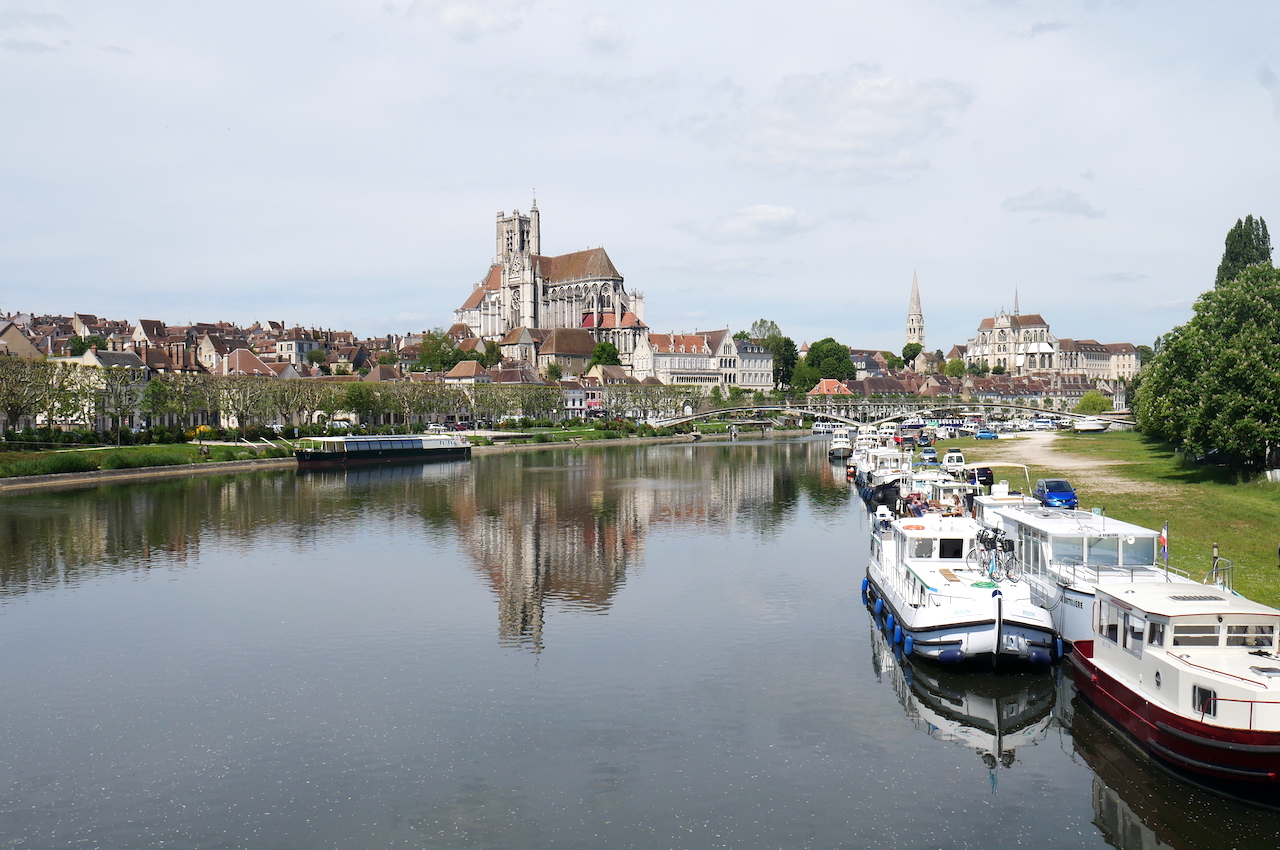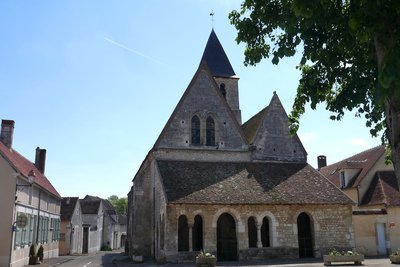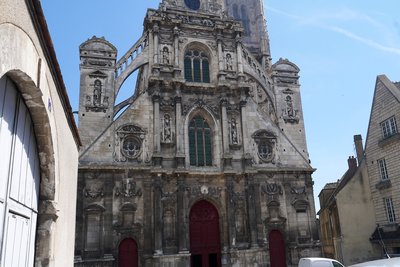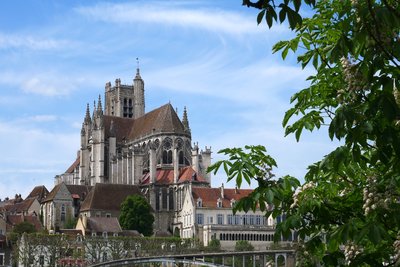Cravant to Auxerre

Bourgogne-Franche-Comté
5. Cravant to Auxerre
Medium
6h
23,6km
+416m
-408m
Step
Embed this item to access it offline
Leaving Cravant you go up to the hill to the famous vineyard. You go around the hill by the paths of the winegrowers to always go down into the vineyards and cross the village of Irancy with its winegrowers. After a walk in the vineyard you go down towards the banks of the Yonne. Cross Champ-sur-Yonne in the direction of the banks of the Yonne. A fisherman's path offers itself to you to wait for Vaux and its beautiful church. Finally the town of Auxerre is in sight with its cathedral and its churches Saint-Pierre and Saint-Germain which stands out from the landscape.
5 points of interest

L‘église Saint-Germain d’Irancy - Amis saint Colomban TouristSt. Germain Church of Irancy
The village of Irinciacum has belonged to the monks of the famous Benedictine Abbey of St Germain d'Auxerre since the 9th century. A diploma (official act) of the Emperor Charles the Bald, grandson of Charlemagne, mentions the vineyard there in 861. During the Wars of Religion (16th century), the village was fortified. The parish church is under the name of the great bishop of Auxerre Saint Germain around 418 to 448. Saint Germain is the patron saint's day of the country.
The square Gothic bell tower flanks the building, whose size is obvious to the eye: the nave of the 12th and 13th centuries, short (three bays) is bordered by two aisles, and the choir is deep. The alterations carried out at the end of the 16th century, in particular the Renaissance-style decoration, are clearly visible in several places: the portal and above all on the buttresses with their rather refined decoration.
Le début du vignoble d’Irancy en arrivant de Cravant - Amis saint Colomban PanoramicVineyard of Irancy
The irancy, is a French red wine of controlled appellation of origin from the vineyards of Burgundy.
Its area of production is spread over the communes of Irancy, Cravant and Vincelottes located about 15 kilometres south-east of Auxerre in the department of Yonne. Irancy is part of the Auxerre vineyard, within the Lower Burgundy vineyard.
From the beginning of the 6th century, the implantation of Christianity had favoured the extension of the vine by the creation of important estates attached to abbeys.
Pinot noir is the main grape variety, with Caesar as a secondary variety. The share of the latter may not exceed 10% of the volume of Irancy.
L’église Saint-Loup de Vaux - Amis saint Colomban TouristSaint-Loup Church in Vaux
Vaux was donated to the Abbey of St-Julien d'Auxerre as soon as it was founded in the 7th century. The church is dedicated to Saint-Loup, bishop of Troyes and companion of Germain d'Auxerre. The ogival vaulted choir is from the 13th century. The church has two naves, the most recent of which was built in the 16th century, and a Romanesque porch built at the end of the 12th century. The main nave, Romanesque, not originally vaulted, was later vaulted in wood as were many churches in the area. Funerary slabs, enriched with inscriptions and figures, can be seen in both naves. Most of them cover the tombs of parish priests.
Façade (17e siècle) de l’église Saint-Pierre d’Auxerre - Amis saint Colomban TouristSt. Peter's Church, Auxerre
The church (16th and 17th centuries) replaces the former abbey church of St. Peter founded in the 6th century. The façade was completed in 1658, the tower was built between 1536 and 1577.
The site has been occupied by a place of worship dedicated to St. Peter since at least the 6th century. Concerning the older occupation of the site, archaeological excavations carried out in 2007 on the northwest side of the present church have demonstrated a continuity of the settlement, which was taken over and modified several times, until the end of the Merovingian period.
In the 8th and 9th centuries, a cemetery was installed in the western part; it then moved closer to the church.
At the same time a community of canons settled on the site.
In 1107, Bishop Humbaud set up canons regular of the Order of Saint Augustine there.
La cathédrale Saint-Étienne d’Auxerre - Amis saint Colomban TouristSaint Stephen's Cathedral, Auxerre
The present cathedral is the fifth sanctuary to have been built since the 5th century.
Following a fire in the 9th century, a Romanesque cathedral was then built by Hugues de Châlon. Built in stone, the new church was consecrated in 1057. Its choir, flanked by two towers, rested on a crypt which served as its foundation because of the slope of the land towards the Yonne.
The construction of the present cathedral began in 1215, under the episcopate of Guillaume de Seignelay, on the basis of the vast Romanesque building of which the 11th century crypt still remains today. The demolition-construction work began simultaneously on the choir (above the crypt) and the south tower of the large west façade.
More info: Wikipedia
Description
In front of the church of Cravant, on the left, pass under the Porte d'Orléans, rue d'Orléans, rue de la Poterne, pass the Porte de la Poterne, go up route d'Irancy.
- Turn left on the asphalt road, go around the hill going down towards Irancy, rue de Cravant, right rue Soufflot, left rue St-Martin, left rue Basse, third street on the right rue des Morts.
- Cross Chemin des Fossés, stay on the tarmac road, second path on the left continue the path through the vineyards, turn left then right at the intersection follow the edge of the wood through the woods
- First road on the left then on the right, intersection with asphalt road on the right.
- Cross the tarred road, take the track in front of you which goes up on your right, at the fork on the right then on the left, cross the tarred road, dirt track opposite, go along the vineyards, cross the D 362.
- Turn right along D 606 to cross it at the level of the track in front of the houses, right rue de Quennes, left, avenue de la gare, third crossroads on the right, rue de la Plaine, left, rue de Saint-Bris, right Route de toussac, left, rue des Prés, right chemin de pêcheurs bordering the Yonne river
- Cross the Yonne river at the Vaux bridge, the Yonne quay on the right, route de Vaux, go along the dry tree park straight ahead place Achille Ribain, rue Max Qantin, rue Amboise Challes, on the left rue Du Pont, first street on the right, rue Saint-Pierre, place Saint-Pierre, on the right rue Joubert, fourth street on the right, rue Philibert Roux, on the left rue Caylus, you arrive at the Saint-Etienne d'Auxerre cathedral.
- Departure : Saint-Pierre et Saint-Paul Church, Promenade Saint-Jean, 89 460 Cravant
- Arrival : Saint Stephen's Cathedral, Saint-Étienne, place Saint-Étienne, 89 000 Auxerre
- Towns crossed : Bourgogne-Franche-Comté
Altimetric profile
Transport
Report a problem or an error
If you have found an error on this page or if you have noticed any problems during your hike, please report them to us here:





